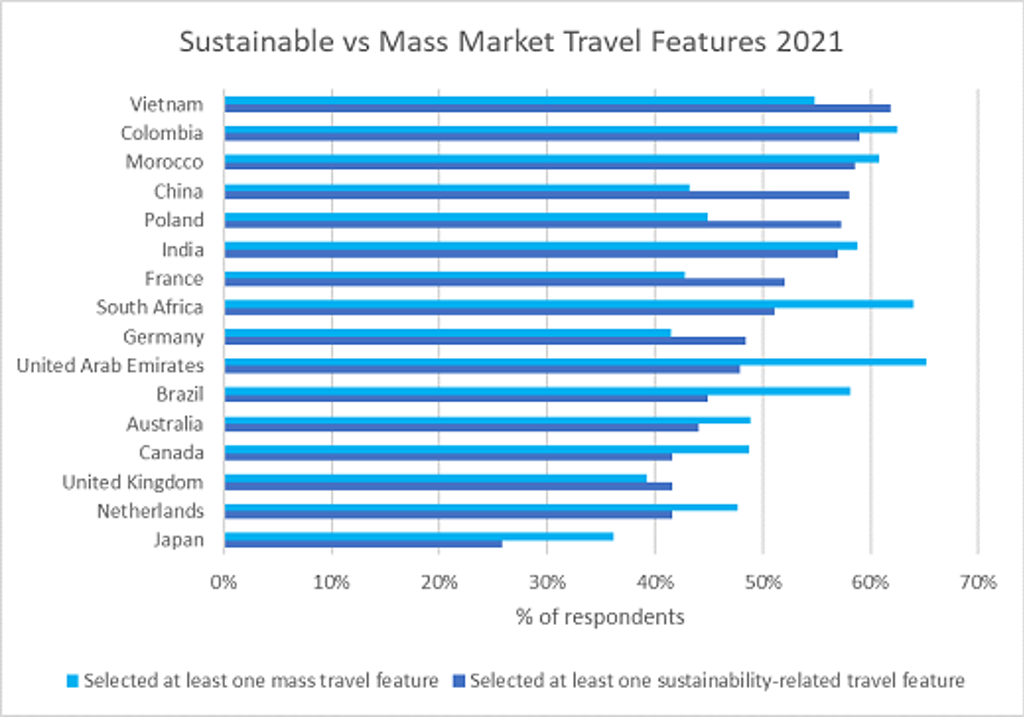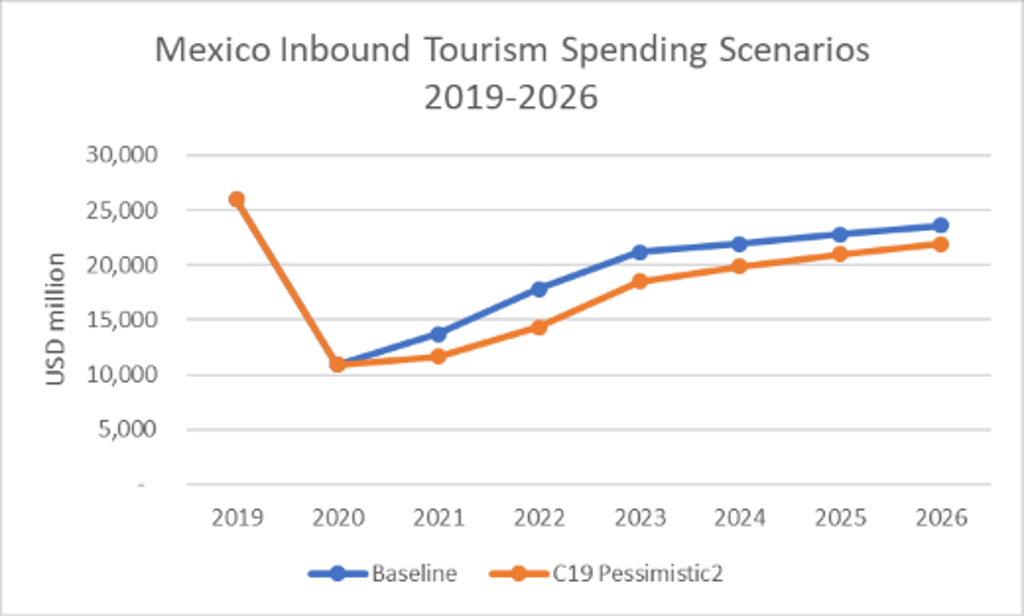Despite, and even because of the pandemic, there has been an increased interest from consumers globally in having a positive impact on the environment through their daily actions, accounting for 66% of global respondents (Euromonitor International – Voice of the Consumer, Lifestyles, Jan 2021)
We also see growing concern from consumers about the impacts of their travel habits and behavior, where for some countries, like China, there is a stronger leaning towards sustainable travel features than the mass market. The gap is also narrowing between mass tourism (currently the more popular, with 52% of global respondents) than sustainable travel options (48%).
The importance of rebuilding tourism in a sustainable way is mission-critical for ensuring that the targets of the Paris Agreement can be met, to avoid multiple tipping points that would lead to global warming above the 1.5c agreed levels, which would be catastrophic for people and the planet. Communities that rely on tourism need to ensure that they protect their local environment and biodiversity, as well as create a more equitable society with opportunities for generations to come.
Where consumers go, business follows
On the flip side, travel businesses are also transitioning to sustainable travel strategies in response to build back better, focusing on high-value growth, not volume-driven growth. Post-pandemic, over-crowding, and the associated health risks will not be tolerated by local communities nor travelers, so there is no choice but to transition to a sustainable business model that protects natural and cultural assets alongside averting the climate emergency.

Source: Euromonitor International – Voice of the Consumer, Lifestyles, fielded in January 2021
Destinations onboard
In Latin America, including Central America and the Caribbean, there are several countries that are performing well in key pillars identified to be relevant for sustainable travel as part of Euromonitor International’s Sustainable Travel (ST) Index.
Across the region, Peru is by the far the most sustainable destination according to the ST index, ranked 31st overall and performing extremely well in the sustainable lodging pillar (ranked second) and sustainable tourism demand pillar (seventh). Over the years, Peru has taken bold steps to diversify and expand its tourism product offer, away from the iconic appeal of Machu Picchu, creating alternative routes and digging deep into its cultural heritage, with gastronomy, arts, heritage, and culture. It benefits from a balanced and diversified lodging supply, with a good balance of hotels and alternative lodging, including short-term rentals and eco-lodges. It has also increasingly created incremental value by driving up average daily spend per trip to boost the revenues kept in communities, optimizing the positive values of tourism.
Environmental stewardship pioneer
Costa Rica is ranked sixth globally in terms of its environmental sustainability. The country is recognised by the UN as a world leader in sustainability that is infused in every aspect of the country’s DNA, including a world-class sustainable tourism offer.
It is an environmental front-runner, and in 2019 declared that it would become climate-neutral by 2050, by launching its long-term strategy for low emissions development. The government realised that failing to act would involve multiple risks, including a negative impact on its competitive advantage to attract visitors and damage its reputation.
The country is a hotspot for biodiversity, with 59% of its forests protected to reverse deforestation and conserve natural ecosystems. The country has achieved near 100% renewable energy capacity. Mobility and electrification of transport are key pillars in its zero-emissions transition, along with biodiversity protection, forestry expansion, and agro-food development. Many of these initiatives continue to be funded by a carbon tax of 3.5% on fossil fuels, launched back in 1997, that raises millions annually.
Green taxes raise valuable revenue to reinvest in sustainability, and if it is transparent, visitors will pay. Costa Rica doubled its rainforest cover in two decades, helped by green taxes.
Garnering social sustainability
Uruguay appeared at eighth position in the ST ranking, experiencing the highest rise in the top 10 over 2015-2020. Its population enjoys the highest levels of freedom in the world, with impressive levels of access to resources, education, and equality. The country’s long-standing National Social Tourism Plan speaks to the country’s ambitions for fostering inclusion and sustainability, acting as the major recovery drivers post-pandemic.

Sustainable Travel Index – Latin America Countries, Rank Position 2020
Source: Euromonitor International
Mexico – long, winding road ahead
The latest forecast outlook from Euromonitor’s Travel Forecast Model indicates that inbound spending will not have reached pre-crisis 2019 levels before 2026, taking over several years even in the baseline scenario.
Mexico is one of the only countries worldwide to have no air travel restrictions, where there is no need to have proof of vaccine or a negative test. However, essential to reopening will be adapting to new travel protocols in key source markets, such as the traffic light systems in the UK as well as digital health passports like IATA Pass and EU Health Certificate. Currently, land border crossings with the US are limited and the CDC advised against all travel from the US to Mexico, even if fully vaccinated. Mexico’s largest sources of inbound tourism receipts will remain the US, Canada, UK, Colombia, and European markets like Spain and France that remain hampered by bans and restrictions.
With the 17 Sustainable Development Goals as a blueprint for recovery and aligning new product development and innovation with consumer desire for more sustainable travel options would help accelerate recovery. Green accreditation and certification from organisations such as the Global Sustainable Tourism Council are but one important piece of the puzzle. Non-profit partnerships, social enterprises, and co-creation would help empower communities, and equally provide a diverse range of sustainable choices and truly unique experiences, steeped in local culture, biodiversity, and adventure to create lifelong emotional connections.

Source: Euromonitor International – Travel Forecast Model, May 2021
For further information, please contact Caroline Bremner, Head of Travel Research, at caroline.bremner@euromonitor.com
